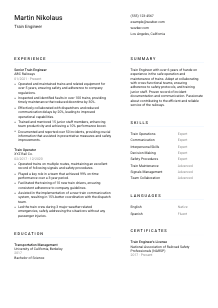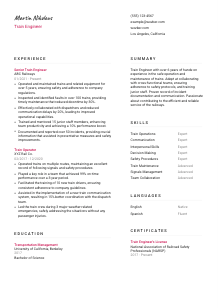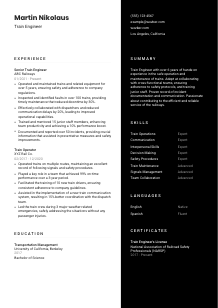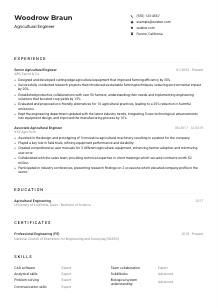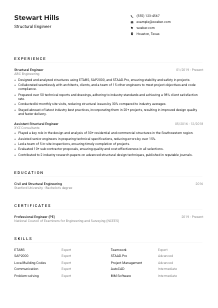Train Engineer Resume Example
Blazing the tracks, but your resume hits a red signal? Steam ahead with this Train Engineer resume example, crafted using Wozber free resume builder. Grasp how to sync your locomotive expertise with job requirements, and get your career journey back on a fast and smooth route!

How to write a Train Engineer Resume?
Embarking on the journey to land your dream Train Engineer position? You've navigated to the right station! Crafting a standout resume is your ticket to get on board in this dynamic profession. With the help of Wozber's free resume builder and this step-by-step guide, we're here to help you engineer a resume that not only meets the job requirements but showcases your unique skills and experiences.
Ready for departure? Let's stoke the boiler and get your career on the fast track to success!
Personal Details
The Personal Details section is the headlight of your resume, illuminating your path to potential employers. For a Train Engineer, this section is more about precision and clarity. Here's how to lay down the tracks.
1. Highlight Your Name
Think of your name as the nameplate on a locomotive: it needs to stand out. Choose a clear font and let it lead the way.
2. Job Title Precision
Directly below your name, station your job title, "Train Engineer", aligning it with the employer's signal. This immediate alignment shows you're on the right track, aiming for their specific role.
3. Signal Your Contact Details
Provide a phone number and a professional email address – think of it as your radio frequency for employers to communicate. Typos can derail your chances, so double-check!
4. Location, Location, Location
Mentioning "Los Angeles, California" illuminates that you're in the right depot, avoiding any relocation concerns from employers.
5. Digital Presence
Including a LinkedIn profile acts as your digital timetable, offering a detailed journey through your professional landscape. Ensure it's synchronized with your resume.
Takeaway
Imagine your personal details as your cab controls, essential for a smooth departure. Keep them neat, professional, and aligned with the Train Engineer role. You're now ready to throttle forward!





Experience
The Experience section is where your resume gathers steam. For a Train Engineer, it's all about demonstrating precision, safety, and reliability. Let's chug through the process of making your experience shine.
- Operated and maintained trains and related equipment for over 5 years, ensuring safety and adherence to company regulations.
- Inspected and identified faults in over 100 trains, providing timely maintenance that reduced downtime by 30%.
- Effectively collaborated with dispatchers and reduced communication delays by 20%, leading to improved operational capabilities.
- Trained and mentored 15 junior staff members, enhancing team productivity and achieving a 10% performance boost.
- Documented and reported over 50 incidents, providing crucial information that assisted in preventative measures and safety improvements.
- Operated trains on multiple routes, maintaining an excellent record of following signals and safety procedures.
- Played a key role in a team that achieved 99% on‑time performance over a 3‑year period.
- Facilitated the training of 10 new train drivers, ensuring consistent adherence to company guidelines.
- Assisted in the implementation of a new train communication system, resulting in 15% better coordination with the dispatch team.
- Led the train crew during 3 major weather‑related emergencies, safely addressing the situations without any passenger injuries.
1. Analyze the Route
Begin with a route map - the job description. Pinpoint requirements such as "operating and maintaining trains" and "effective collaboration with dispatchers", to ensure your experience aligns perfectly.
2. Build Your Itinerary
Structure your employment journey chronologically, highlighting positions that showcase your relevancy to the Train Engineer role, signaling your suitability for the position.
3. Detail Your Journey
For each role, lay out specific accomplishments such as "inspected and identified faults in over 100 trains." This specificity is your cargo, carrying weight and demonstrating your value.
4. Quantify Your Mileage
Incorporate numbers wherever possible. If you improved operational capabilities by reducing communication delays with dispatchers by 20%, it's a quantifiable proof of your impact.
5. Stay on Track
Keep your experience relevant. While being a hobbyist model train collector is interesting, unless it directly impacts your skills as a Train Engineer, it's best left at the station.
Takeaway
Your experience section is your express line to standout candidacy. Tailor it, quantify your achievements, and ensure it resonates with the role of a Train Engineer. Full steam ahead!
Education
In the vast landscape of your resume, your education forms the railway foundation. For a Train Engineer, it's about showcasing relevant education that powers your ability to handle the complexities of the role.
1. Identify the Required Depot
Know what educational stops are on the job description's route. While specific degrees may not be listed, any foundational courses or degrees in Transportation Management, like our example, can enhance your candidacy.
2. Plan Your Educational Route
List your educational milestones clearly: degree, institution, and year of graduation. This clarity is like ensuring your signals are visible and understood.
3. Highlight Your Relevant Courses
Though specific courses weren't needed in our example, pointing out relevant coursework can serve as additional fuel, showing your preparedness for the job.
4. Showcase Additional Achievements
If you have additional accolades or education that aligns with the role of Train Engineer, such as safety certifications, signal these achievements. They're extra carriages of credibility.
5. Keep the Cargo Light
In the engineering control room, every tool has a purpose. Similarly, ensure every part of your education section serves the goal of steering you towards the Train Engineer role.
Takeaway
Your education section is the bedrock of your resume train, supporting your journey. Craft it to show how it's prepared you for the specifics of the Train Engineer role. Next stop: Certification!
Certificates
In this profession, staying current with certifications is like maintaining the engine's efficiency. It demonstrates your commitment to safety, knowledge, and continuous improvement.
1. Feature Relevant Certifications
Highlight certificates that directly enhance your candidacy as a Train Engineer, such as a "Train Engineer's License" from NARSP. It's like having a specialized tool in your toolkit.
2. Update Your Documentation
Just like how a locomotive requires regular inspections, keep your certificates up-to-date. This shows employers your continuous commitment to your profession.
3. Present with Clarity
When listing your certifications, be clear about the issuer and the validity period. It's similar to running a train schedule – precision and clarity are key.
4. Explore Continuous Learning Opportunities
The rail industry, like any other, is evolving. Continuous learning through certification is your ticket to staying relevant and competitive.
Takeaway
Certificates in your resume are like safety certifications for a locomotive - they're essential for proving your qualifications and dedication. Keep them updated and relevant to showcase your expertise.
Skills
Think of the Skills section as equipping the cab of your locomotive. Each skill you list is an instrument or control you'll use to navigate your journey as a Train Engineer efficiently and safely.
1. Inventory Your Controls
Starting with the job requirements, identify hard and soft skills that power your role as a Train Engineer. Skills like "Train Operations", "Safety Procedures", and "Effective Communication" are direct matches to the job description.
2. Prioritize Essential Equipment
Choose the skills that are most relevant to the role, showing you have the right tools for the job. Your ability to make quick decisions during emergencies is just as crucial as your technical skill in operating the trains.
3. Organize for Quick Access
Keep your skills section tidy and accessible. Present them in a way that a hiring manager can quickly scan and recognize your aptitude for the job. Think of it as organizing the cab for efficiency.
Takeaway
Your Skills section is your control panel, showcasing your readiness to navigate the tracks safely and efficiently. By aligning your skills with the job description, you signal to employers that you're the right engineer for the job.
Languages
While the primary language of the rails might be whistles and signals, being multilingual can be a unique asset, especially in diverse environments like Los Angeles, California.
1. Verify Communication Signals
Begin by listing English as your primary language, as requested in the job description. This assures employers of your ability to follow safety procedures and communicate clearly.
2. Add Auxiliary Languages
If you're fluent in additional languages, list them. It's like having extra frequency bands on your radio, enhancing communication in diverse work environments.
3. Rank Your Proficiency
Be honest and clear about your language proficiency levels. Whether you're 'Native', 'Fluent', 'Intermediate', or 'Basic', clarity here ensures there are no miscommunications.
4. Assess the Geography
In a position that might interact with a diverse crew or passenger base, such as in Los Angeles, additional language skills can enhance your capability to manage effectively.
5. Continuous Learning
Like updating a train's navigation system, continuously improving your language skills can open new routes in your career journey.
Takeaway
Your language skills are additional lines on your railway map, expanding your reach and effectiveness in the role of a Train Engineer. Highlight them as assets that enhance your ability to communicate and operate within a diverse environment.
Summary
Your resume's Summary section is the express line: it delivers a quick, potent introduction of who you are as a Train Engineer. Craft it to engage the hiring manager's attention and keep them reading.
1. Boarding Announcement
Begin with a strong, confident introduction that encapsulates your experience and expertise as a Train Engineer.
2. Highlight Major Stops
Include a brief overview of key skills and achievements that are directly relevant to the job description, like "ensuring safety and adherence to company regulations" or "reducing downtime by 30% through timely maintenance."
3. Signal Your Destination
Conclude with a forward-looking statement, signaling your enthusiasm and readiness to contribute to your potential employer's success.
4. Keep the Journey Short
Remember, the Summary is just the beginning of your journey. Keep it concise, focusing on the most compelling parts of your career narrative.
Takeaway
Your Summary is your chance to shine, to signal to employers that you're exactly what they're looking for in a Train Engineer. By focusing on your achievements and skills that align with the job description, you grab their attention and set the stage for the rest of your resume.
Launching Your Train Engineer Journey
You're now equipped with all the insights to craft a compelling resume that speaks to your strengths and closely aligns with the Train Engineer position you're aiming for. Using Wozber, you have at your disposal a free resume builder that guides you through creating an ATS-compliant resume, ensuring your application navigates through the filters and lands on the right desk. Remember, each section of your resume is a carriage in your career train, and when connected seamlessly, they transport you towards your goals. All aboard for success!

- Minimum of 5 years of experience operating and maintaining trains or related equipment.
- Possession of a valid Train Engineer's License or certification from the National Association of Railroad Safety Professionals (NARSP)
- Strong knowledge of train operations, signals, and safety procedures.
- Effective communication and interpersonal skills to collaborate with train crew, dispatchers, and maintenance personnel.
- Ability to remain calm and make quick decisions during potential emergencies or unexpected incidents.
- The job requires the ability to articulate in English clearly.
- Must be based in Los Angeles, California.
- Operate locomotives and trains in a safe, efficient, and timely manner, adhering to all company and regulatory guidelines.
- Inspect trains before and after each run to ensure proper operation and identify any faults or malfunctions.
- Coordinate with dispatchers to maintain accurate schedules, update on delays or changes, and obtain necessary clearances.
- Train and mentor new hires or junior staff regarding train operations and safety protocols.
- Document and report any incidents, accidents, or unusual occurrences to the relevant authorities or personnel.





